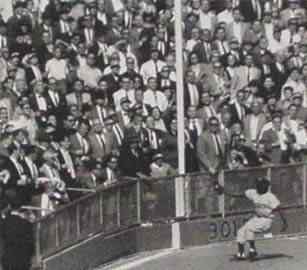Tuesday, January 30, 2007 |
Today's Birthdays

The Catch That Saved The Dodgers
Sandy Amoros LAN,BRO b. 1930, played 1952, 1954-1957, 1959-1960, d. 1992-06-27. In the sixth inning of Game 7 of the 1955 World Series, Walter Alston made a little-remarked-upon change that was about to have huge consequences for the Dodgers, pulling left fielder Jim Gilliam for the left-handed thrower Amoros. Bums recalls the drama:
It was 2 to 0, Dodgers, in the bottom of the sixth, when with one out the Yankees put two men on base: [Billy] Martin walked, and then Gil McDougald bunted safely. Two on, one out. [Yogi] Berra up. A home run and it was over for the Dodgers.(Thanks to the NLBPA website for typing that in so I didn't have to.)
It was getting late in the game, [starter Johnny] Podres seemed to be tiring, and Berra was a dead pull hitter, so the entire Brooklyn outfield, Amoros, [Duke] Snider, and [Carl] Furillo, was shifted over toward right. Amoros, the left fielder, was shaded so far over he could have been the center fielder.
Podres threw an outside pitch. Berra slapped his bat on it late as it was crossing the plate. The Yankee catcher was protecting the plate and sent a looping, climbing pop toward the left-field line, in the direction of the low barrier in left field.
Had Junior Gilliam still been in left, the Dodgers would have lost the game and the Series, for even with Gilliam's good speed, he would not have caught Berra's ball. Gilliam, moreover, was right handed, which would have made the catch very difficult. Of all the moves Alston ever made, this one must have been blessed, because he needed a man with special attributes to make the catch. And Sandy Amoros was there.
The nimble Cuban turned and fled toward the foul pole, and as he was nearing the dirt warning track at top speed, he extended his right, gloved hand, and the descending ball neatly fell into it as he took a series of quick, mincing steps to keep from banging into the low fence before him. On the field there was confusion in the Yankee camp, while Dodger heads remained cool. Pee Wee Reese had run down the third-base line for the relay. He called for the ball, and Amoros hit him in the chest, and without hesitation Reese fired over to Gil Hodges at first, where the base umpire signaled the hasty McDougald out. McDougald, who had not figured Amoros to catch the ball, had run almost to second base and was caught stranded for the third out.
The sixth inning was over. The Yankee rally was aborted. The scoreboard indicated 2 for the Dodgers. The Yankees still had nothing.
Of all the possible Dodger heroes, Amoros was among the most unlikely. He was virtually invisible to the public, for he spoke no English and was unusally diffident for a professional athlete. Reporters didn't ask him questions, because they knew he couldn't answer. Sometimes they would wave, and he would smile and nod. Sandy lived like a gypsy while on the Dodgers. He never rented an apartment, but most of the time lived on Roy Campanella's yacht. Roy had learned to speak Spanish playing winter ball in the Caribbean.
Amoros had been one of the greatest players ever to come out of pre-Castro Cuba. If he had spoken English, he certainly would have played more, because in Cuba he was a .300 hitter in a fast league, was fleet in the field, was excellent at stealing bases, and was a good bunter. But he didn't learn the language, and it was a handicap that kept him from becoming a star. A manager just doesn't trust employing a player when he isn't sure whether the guy understands him or not.
Mal Mallette BRO b. 1922, played 1950, d. 2005-11-25
Charlie Neal LAN,BRO b. 1931, played 1956-1961, All-Star: 1959-1960, d. 1996-11-18. 1957 marked the beginning of the end of the Boys of Summer Dodgers; Pee Wee Reese would turn 38 in June, and had lost his quickness at short. Jackie Robinson was more-or-less forced into retirement in December, 1956, refusing a trade to the Giants. Charlie Neal came in to replace both men at short and second, moving permanently to second in 1958. He stayed there until December, 1961, when he was traded to the expansion Mets, with Jim Gilliam taking his place at second.
Red Smyth BRO b. 1893, played 1915-1917, d. 1958-04-14
Newer› ‹Older


Post a Comment
Note: Only a member of this blog may post a comment.